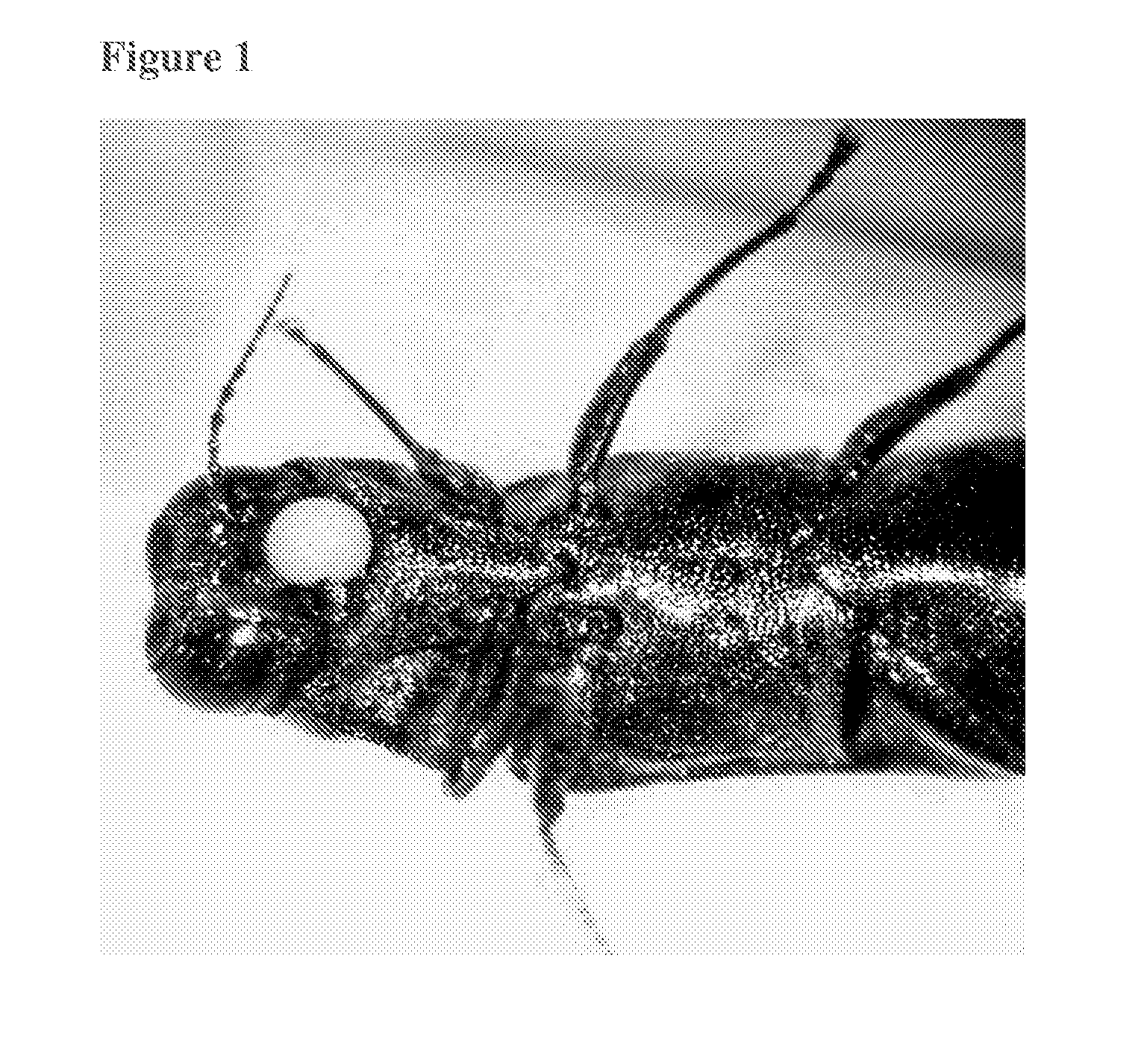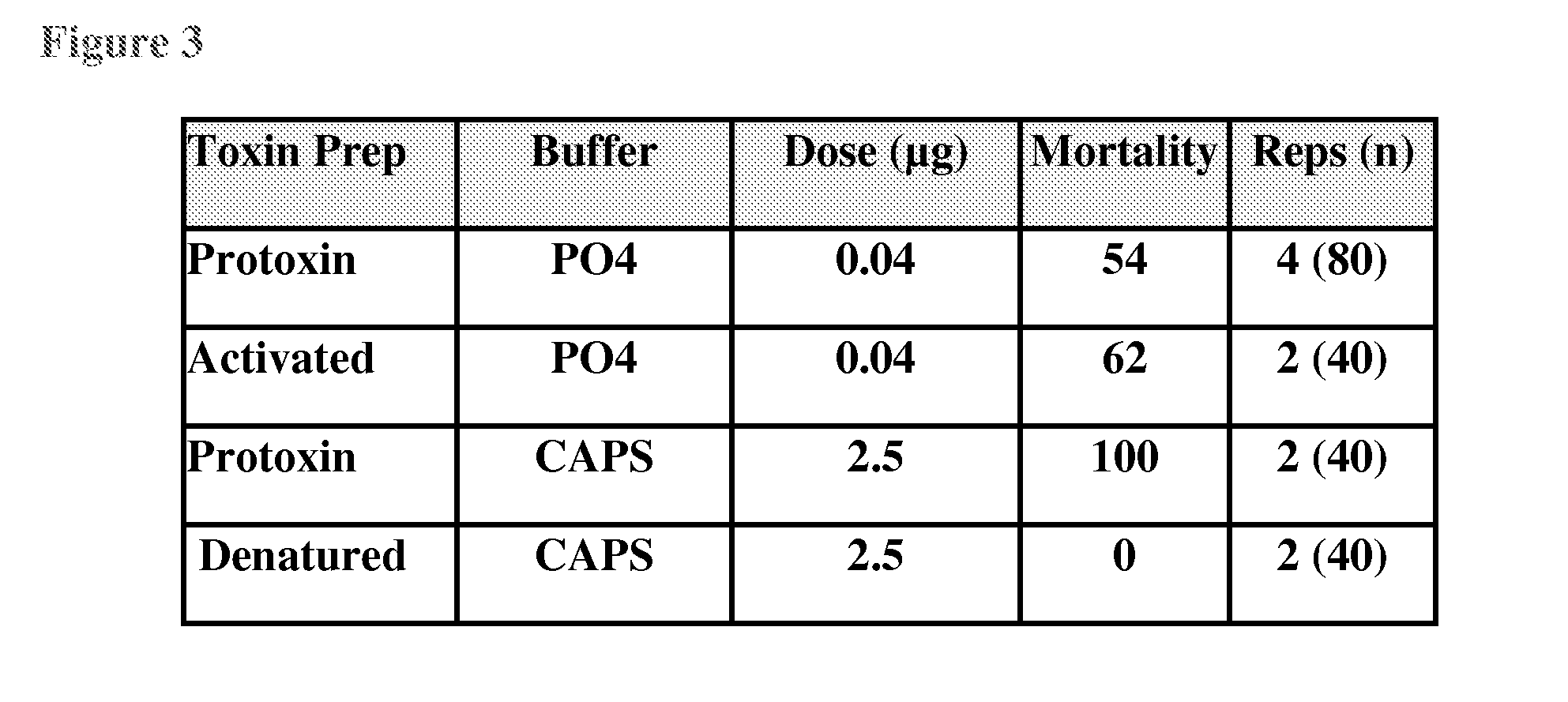Protein having pesticidal activity, DNA encoding the protein, and noxious organism-controlling agent that controls the insect pest, emerald ash borer (EAB), agrilus planipennis
a technology of pesticides and proteins, applied in the field of pesticides and noxious organisms, can solve the problems of difficult quantification or prediction of ecological impact of eab on forested areas, eab compliance and enforcement remains a problem, and the effect of increasing the insecticidal activity of sds502 material
- Summary
- Abstract
- Description
- Claims
- Application Information
AI Technical Summary
Benefits of technology
Problems solved by technology
Method used
Image
Examples
example 1
The Cry8Da Protein is Toxic to EAB Adults and Larvae
[0067]Bioassay results of adult EAB with both the Cry8Da protoxin and Cry8Da activated toxin, solubilized in 50 mM NaPO4 buffer at pH 8.0, demonstrated relatively high toxicities, with 96-h LD50s ranging from 0.04 to 0.10 μg Cry toxin. Similar toxicities for both protoxin and activated toxin indicate EAB midgut enzymes are capable of activating this toxin. The denatured Cry8Da toxin was not toxic to EAB adults receiving doses of 2.5 ug toxin, denatured by boiling in 50 mM CAPS buffer pH 10 for 20 min, whereas all EAB adults died within 72 h of receiving similar doses of non-denatured Cry8Da toxin. This confirmed EAB adult mortality in our bioassays was caused by SDS502 Cry8Da protein, and is the first Cry toxin with confirmed toxicity against EAB. Bioassays evaluating the toxicity of Cry8Da in EAB larvae likewise confirmed insecticidal activity against the larval form of EAB.
example 2
The Cry8Da Protein Crystal-Spore Mix is Toxic to EAB Adults and Larvae
[0068]In addition to the purified forms of the Cry8Da protein, the native form of this protein was also tested against EAB adults and larvae.
[0069]Bt cultures were grown in DSMG media in shaker water bath culture, crystal / spore spun down at 27,000 g and washed at 20,000 g with sterile DW and NaCl, resuspended in sterile DW and sonicated, dilutions loaded on SDS PAGE, and protein concentrations determined using densitometer using Gel Doc correlated with the BSA as standard curve.
[0070]In brief: even-aged cohorts of female & male EAB adults were dosed individually with 0.5 uL droplets of Btg SDS-502 crystal / spore complex, which was a freeze-dried powder with known concentration of Cry8Da toxin. The powder was suspended in DW and serial dilution of the stock suspension was diluted to prepare doses of 0.03125, 0.0625, 0.125, 0.25, 0.5 ug Cry toxin, with DW used as the control. We dosed 15 EAB individually for each of ...
example 3
The SDS502 Technical Powder is Toxic to EAB Adults and Larvae
[0071]EAB mortality was demonstrated in leaf dip assays in which Ash leaves were dipped in SDS502 technical powder that was suspended in Silwet.
[0072]The SDS502 strain was cultured in a medium in which general bacteria can grow by a common fermentation technique. The following medium was used in a 5 liter fermentation of SDS502 to produce the technical powder:
Glucose Fed-Batch Type Fermentation
[0073]4% (40 g / L) Defatted Soy flour[0074]1 g / L NH4Cl[0075]1.5 g / L KH2PO4 [0076]3.5 g / L K2HPO4 [0077]0.5g / L MgSO4 7H2O[0078]10 mg / L FeSO4 7H2O[0079]10 mg / L MnSO4 H2O[0080]pH adjust to 7.0 with KOH or H2SO4
[0081]Run fed batch with glucose feeding (feeding rate: 0.0125% of medium volume / hr (0.125 g / L / hr)) from 3 hr to 16 hr. Following the fermentation, the solid material was then centrifuged and spray-dried. The material was then tested.
[0082]In contrast to using the SDS502 strain and / or SDS502 strain-produced crystal protein as a sin...
PUM
| Property | Measurement | Unit |
|---|---|---|
| pH | aaaaa | aaaaa |
| pH | aaaaa | aaaaa |
| diameter | aaaaa | aaaaa |
Abstract
Description
Claims
Application Information
 Login to View More
Login to View More - R&D
- Intellectual Property
- Life Sciences
- Materials
- Tech Scout
- Unparalleled Data Quality
- Higher Quality Content
- 60% Fewer Hallucinations
Browse by: Latest US Patents, China's latest patents, Technical Efficacy Thesaurus, Application Domain, Technology Topic, Popular Technical Reports.
© 2025 PatSnap. All rights reserved.Legal|Privacy policy|Modern Slavery Act Transparency Statement|Sitemap|About US| Contact US: help@patsnap.com



